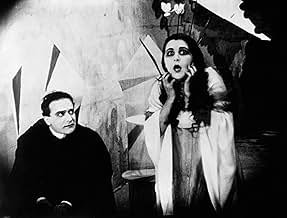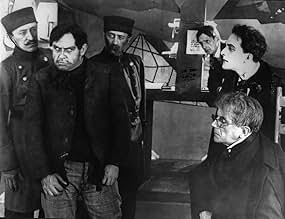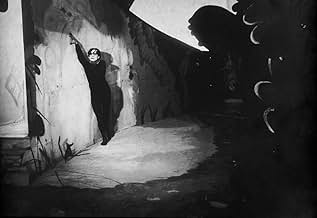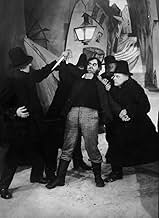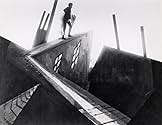IMDb RATING
8.0/10
73K
YOUR RATING
Hypnotist Dr. Caligari uses a somnambulist, Cesare, to commit murders.Hypnotist Dr. Caligari uses a somnambulist, Cesare, to commit murders.Hypnotist Dr. Caligari uses a somnambulist, Cesare, to commit murders.
- Awards
- 2 wins & 1 nomination total
Friedrich Feher
- Franzis
- (as Friedrich Fehér)
Hans Heinrich von Twardowski
- Alan
- (as Hans Heinz v. Twardowski)
Rudolf Lettinger
- Dr. Olsen
- (as Rudolph Lettinger)
Rudolf Klein-Rogge
- Ein Verbrecher
- (uncredited)
- …
Hans Lanser-Ludolff
- Ein Alter Mann
- (uncredited)
- …
Henri Peters-Arnolds
- Ein Junger Arzt
- (uncredited)
- …
Ludwig Rex
- Ein Mörder
- (uncredited)
- …
Elsa Wagner
- Die Wirtin
- (uncredited)
- …
- Director
- Writers
- All cast & crew
- Production, box office & more at IMDbPro
Storyline
Did you know
- TriviaWriter Hans Janowitz claims to have gotten the idea for the film when he was at a carnival one day. He saw a strange man lurking in the shadows. The next day he heard that a girl was brutally murdered there. He went to the funeral and saw the same man lurking around. He had no proof that the strange man was the murderer, but he fleshed the whole idea out into his film.
- GoofsIn the wide shot, the sign at the asylum reads "Insane Asylum," in English. In the close-up, the sign is written in German (Kino Blu-ray Disc version, may not be present in all editions of the film).
- Alternate versionsUSA laserdisc reissue restores the original hand-drawn title cards that have been missing from every known print of the film since 1923. When first released on video in the United States, film was in black-and-white, and played back many scenes at double speed and featured different music. Although no scenes were cut out, the running time was reduced to only 51 minutes. The restored version restores the colour-tinting, restores the original title cards, and plays the film back at regular speed, returning the film to its original 69-minute running time.
- ConnectionsEdited into People Who Die Mysteriously in Their Sleep (2004)
Featured review
I vowed to see more horror films this year, and this was recommended to me, initially I was a little dubious with it being a hundred plus years old, and a silent film, but I have to say I have a real appreciation for it.
Without a doubt, this film must be the inspiration for the whole horror genre, a genre that scares and shocks people to this day, you can only I shine the profound effect that this film must have had on viewers back in its time.
Hugely atmospheric and creepy, if I'm honest, it is slow, and you do need to concentrate, or you'll lose it, no texting or phone play, it is a fairly intense watch, best of all is the ending, which really does come as a surprise, it's something of a twist.
It is definitely not for everyone, and if you're used to modern horror, you may find ten minutes of it an arduous task, but having watched Nose earlier in the year, I have a real appreciation for this early gem.
An admirable film, 8/10.
Without a doubt, this film must be the inspiration for the whole horror genre, a genre that scares and shocks people to this day, you can only I shine the profound effect that this film must have had on viewers back in its time.
Hugely atmospheric and creepy, if I'm honest, it is slow, and you do need to concentrate, or you'll lose it, no texting or phone play, it is a fairly intense watch, best of all is the ending, which really does come as a surprise, it's something of a twist.
It is definitely not for everyone, and if you're used to modern horror, you may find ten minutes of it an arduous task, but having watched Nose earlier in the year, I have a real appreciation for this early gem.
An admirable film, 8/10.
- Sleepin_Dragon
- Dec 17, 2022
- Permalink
Details
- Release date
- Country of origin
- Language
- Also known as
- El gabinete del Dr. Caligari
- Filming locations
- Production company
- See more company credits at IMDbPro
Box office
- Budget
- $18,000 (estimated)
- Gross US & Canada
- $8,811
- Gross worldwide
- $9,297
- Runtime1 hour 7 minutes
- Sound mix
- Aspect ratio
- 1.37 : 1
Contribute to this page
Suggest an edit or add missing content

Top Gap
By what name was The Cabinet of Dr. Caligari (1920) officially released in India in English?
Answer

